With our HealthConsuming “health is everywhere” ethos, this post updates some of the most impactful recent retail health developments shaping consumers’ health/care touchpoints beyond hospitals, physicians, and health plans.
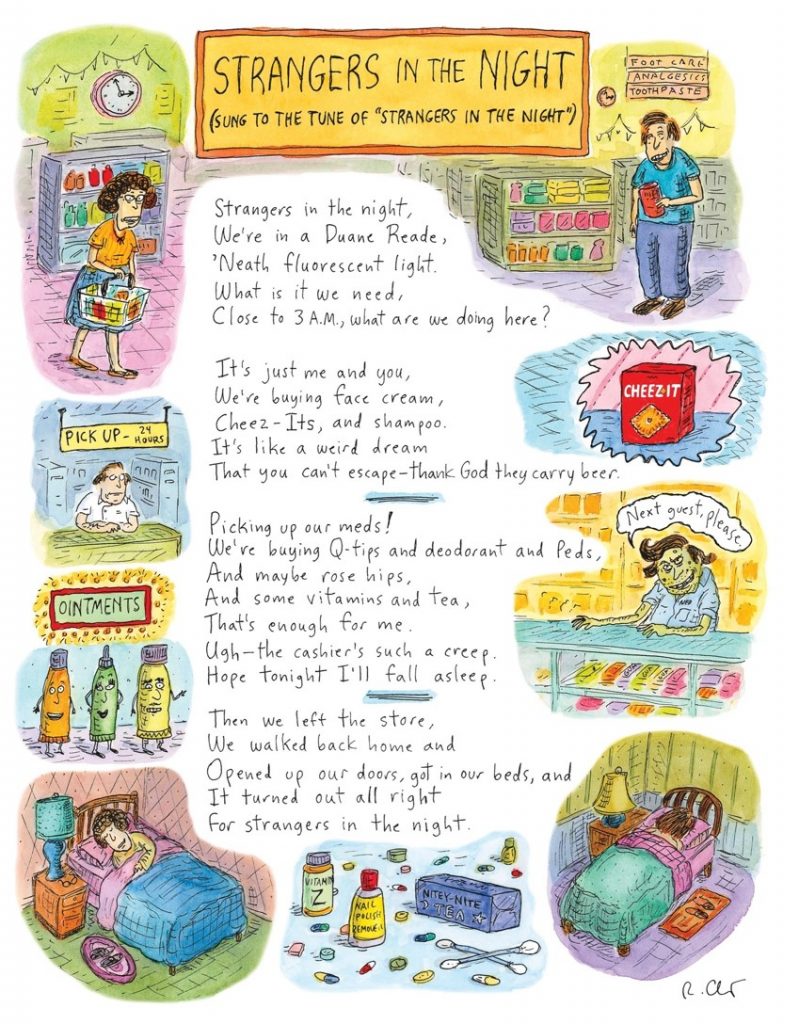
For inspiration and context, I’ll kick off with Roz Chast’s latest New Yorker cartoon from the February 3rd 2020 issue — Strangers in the Night, taking place in a Duane Reade pharmacy. Roz really channels the scene in front of the pharmacy counter, from Q-tips to vitamins and tea. And it’s hummable to the tune of, well, Strangers in the Night. Check out the 24-hour pharmacist under the pick-up sign.
Now, to the news….and what it means…
Start with Kroger and Hy-Vee, national grocery chains, both of which are expanding their health care reach via pharmacists’ licensure practice expansions, and new concepts of mobile health.
Kroger begun offering smoking cessation programs through the stores’ (Kroger, Fred Meyer and Smith’s) pharmacists. The pharmacist consults with a consumer seeking to quit tobacco, and is prescribed an Rx for smoking cessation coupled with therapy and counseling. If the consumer holds a Kroger Rx Savings Club card, then she gets a discount on products purchased in the pharmacy. The American Pharmacists Association offers additional insights on the program here.
Hy-Vee is expanding the definition of “mobile health” through the store’s Health You Mobile RVs, vans that drive into the stores’ communities offering preventive cardiovascular care. The heart-health programs include free biometric screenings coupled with nutrition counseling through store dieticians. Dieticians also test for various metrics via a blood sample from a finger prick, checking cholesterol and glucose, along with blood pressure and BMI. Supermarket News offered more details on the program.
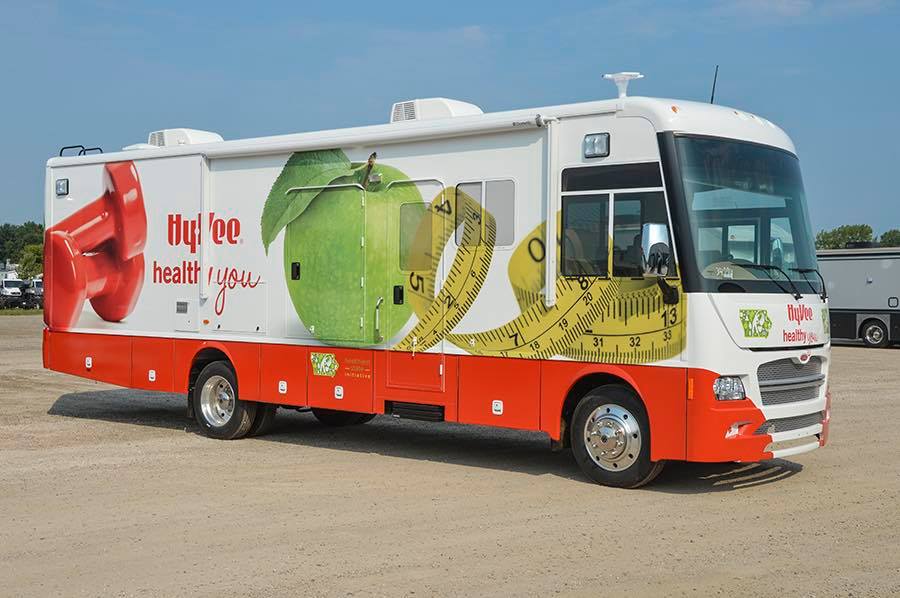 Publix announced that it would launch its 13th in-hospital pharmacy in August 2020, at the Halifax Health Medical Center in Daytona Beach, FL. In addition to providing over-the-counter meds and other products, the in-hospital shop will deliver patients’ orders to the bedside before they are discharged home. While the grocer’s baker’s dozen of in-hospital pharmacies are only in Florida thus far, the company intends to expand into the other six states where Publix grocery stores operate.
Publix announced that it would launch its 13th in-hospital pharmacy in August 2020, at the Halifax Health Medical Center in Daytona Beach, FL. In addition to providing over-the-counter meds and other products, the in-hospital shop will deliver patients’ orders to the bedside before they are discharged home. While the grocer’s baker’s dozen of in-hospital pharmacies are only in Florida thus far, the company intends to expand into the other six states where Publix grocery stores operate.
Beyond the grocery store is a Big Box store called Walmart — ever-growing and morphing as a health care provider and supplier for consumers across America.
 Walmart opened its second health center, in Calhoun, GA (the first center was established in Dallas, GA). This is a multi-service health center, including primary and urgent care, labs, x-ray and diagnostics, counseling, dental, optical and audiology services under one roof. Pricing for these services is transparent, published on a visible list.
Walmart opened its second health center, in Calhoun, GA (the first center was established in Dallas, GA). This is a multi-service health center, including primary and urgent care, labs, x-ray and diagnostics, counseling, dental, optical and audiology services under one roof. Pricing for these services is transparent, published on a visible list.
CVS/health is growing its reach into the social determinants of health through its Destination: Health program. Think past the pharmacy and the company’s new Health Hub concept; think CVS/housing. The company invested $67 million in affordable housing in 2019, which built 2,200 homes in 24 cities in six states. Health citizens who will live in these homes will include people who have survived domestic violence, homelessness, chronic illness, or dealt with behavioral health and addiction, along with seniors, veterans and their families. This year CVS/health will invest at least $25 in homes in Ohio.
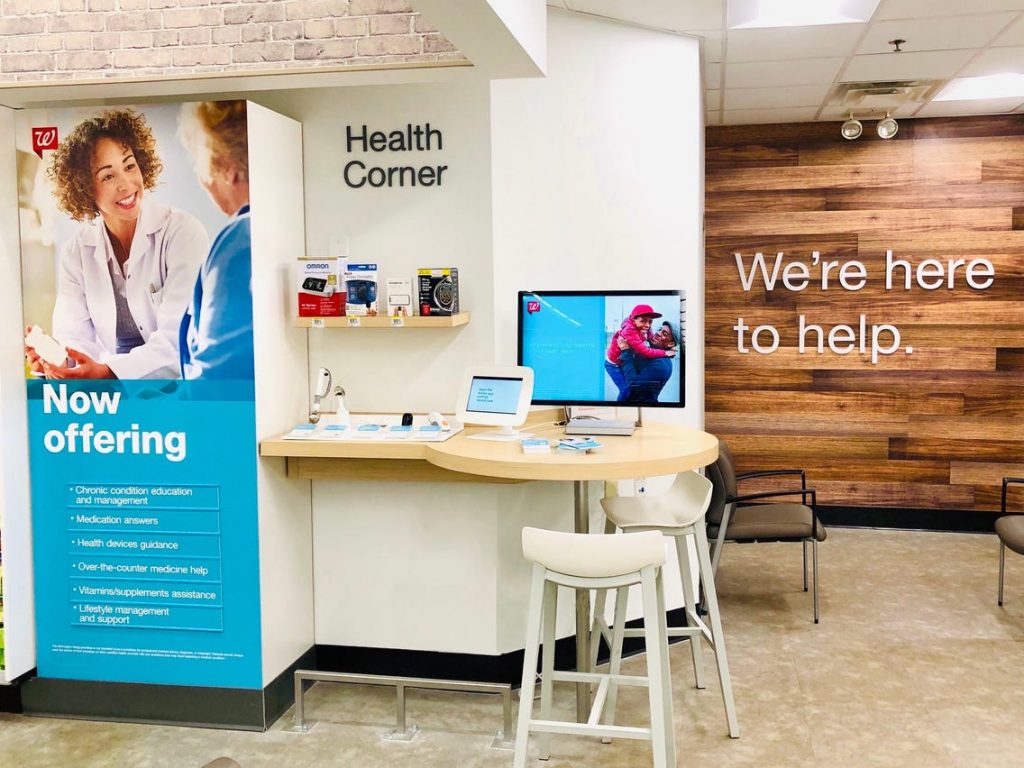 As CVS has its Health Hub, so Walgreens will have the “Health Corner,” a new concept being launched with guidance from Microsoft. as reported in Becker’s Hospital Review. The so-called Health Corners will launch in Walgreens pharmacies in Tennessee, expanding the pharmacy’s version 1.0 Take Care Clinic concept into a service with private clinic rooms enabling consumers to meet with pharmacists to discuss prescription drugs, digital health tools (which Walgreens customers can score points from using via the Balance Rewards program), Becker’s reports from a Business Insider story. The piece calls out other partners beyond Microsoft with whom Walgreens is working for building its health/care ecosystem, including Humana, Jenny Craig, Kroger, UnitedHealthcare and VillageMD.
As CVS has its Health Hub, so Walgreens will have the “Health Corner,” a new concept being launched with guidance from Microsoft. as reported in Becker’s Hospital Review. The so-called Health Corners will launch in Walgreens pharmacies in Tennessee, expanding the pharmacy’s version 1.0 Take Care Clinic concept into a service with private clinic rooms enabling consumers to meet with pharmacists to discuss prescription drugs, digital health tools (which Walgreens customers can score points from using via the Balance Rewards program), Becker’s reports from a Business Insider story. The piece calls out other partners beyond Microsoft with whom Walgreens is working for building its health/care ecosystem, including Humana, Jenny Craig, Kroger, UnitedHealthcare and VillageMD.
Health Populi’s Hot Points: Check out the design elements in the Walmart health center waiting room or the warm wood texture of the Walgreens Health Corner. These don’t look much like “healthcare” clinics, do they?
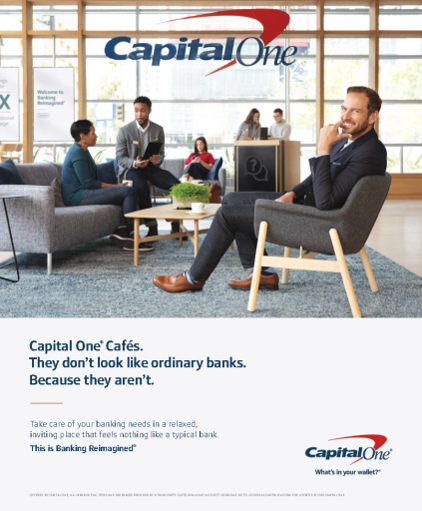 Or consider the Hy-Vee mobile truck checking heart health. Is this a clinic? Is it a mobile app?
Or consider the Hy-Vee mobile truck checking heart health. Is this a clinic? Is it a mobile app?
Now look at this ad from Capital One, published in the issue of the New Yorker containing Roz Chast’s cartoon.
Have you visited a Capital One Café? It doesn’t feel much like a bank. It feels like, well, a café.
The tagline reads, “This is Banking Reimagined.”
Now ponder…what would healthcare reimagined look like.
Something like Hy-Vee’s Health You RVs or a Walmart Health Center or perhaps Walgreens’ new Health Corner model.
As patients continue take on financial risk for paying for health care, now as medical bill payers and health consumers, these are the UX-designed experiences for health care people want to frequent (when they choose to access health care services). While not all health care is shoppable, the primary care, pharmacy, smoking cessation, vision and hearing and therapeutic services that are consumer-facing will increasingly take on the look and feel of reimagined spaces and places…including our own homes.
Hey, Nespresso has reimagined us all as baristas in our homes. So, too, are Samsung, Omron, Philips, Apple, Amazon, Johnson & Johnson and innumerable health/care developers working in this way to enable us to be our best self-care selves.


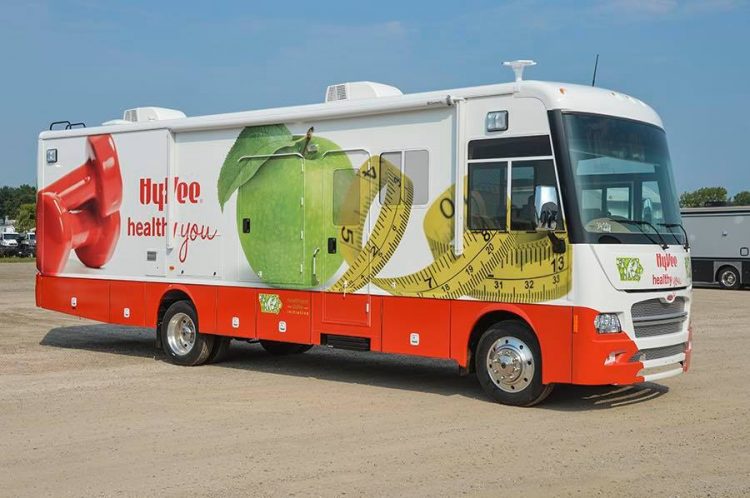


 I'm in amazing company here with other #digitalhealth innovators, thinkers and doers. Thank you to Cristian Cortez Fernandez and Zallud for this recognition; I'm grateful.
I'm in amazing company here with other #digitalhealth innovators, thinkers and doers. Thank you to Cristian Cortez Fernandez and Zallud for this recognition; I'm grateful. Jane was named as a member of the AHIP 2024 Advisory Board, joining some valued colleagues to prepare for the challenges and opportunities facing health plans, systems, and other industry stakeholders.
Jane was named as a member of the AHIP 2024 Advisory Board, joining some valued colleagues to prepare for the challenges and opportunities facing health plans, systems, and other industry stakeholders.  Join Jane at AHIP's annual meeting in Las Vegas: I'll be speaking, moderating a panel, and providing thought leadership on health consumers and bolstering equity, empowerment, and self-care.
Join Jane at AHIP's annual meeting in Las Vegas: I'll be speaking, moderating a panel, and providing thought leadership on health consumers and bolstering equity, empowerment, and self-care.